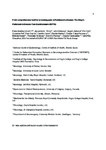First comprehensive tool for screening pain in Parkinson's disease: The King's Parkinson's Disease Pain Questionnaire (KPPQ).
| dc.contributor.author | Martinez-Martin, P | |
| dc.contributor.author | Rizos, AM | |
| dc.contributor.author | Wetmore, J | |
| dc.contributor.author | Antonini, A | |
| dc.contributor.author | Odin, P | |
| dc.contributor.author | Pal, S | |
| dc.contributor.author | Sophia, R | |
| dc.contributor.author | Carroll, C | |
| dc.contributor.author | Martino, D | |
| dc.contributor.author | Falup-Pecurariu, C | |
| dc.contributor.author | Kessel, B | |
| dc.contributor.author | Andrews, T | |
| dc.contributor.author | Paviour, D | |
| dc.contributor.author | Trenkwalder, C | |
| dc.contributor.author | Chaudhuri, KR | |
| dc.contributor.author | EUROPAR & MDS Non-Motor PD Study Group, | |
| dc.date.accessioned | 2018-06-15T10:36:07Z | |
| dc.date.issued | 2018-10 | |
| dc.identifier.issn | 1351-5101 | |
| dc.identifier.issn | 1468-1331 | |
| dc.identifier.uri | http://hdl.handle.net/10026.1/11666 | |
| dc.description.abstract |
BACKGROUND: Pain is highly prevalent in Parkinson's disease (PD), impacting patients' ability, mood, and quality of life. Detecting the presence of pain in its multiple modalities is necessary for adequate personalized management of PD. A 14-item, PD-specific, patient-based questionnaire (the King's Parkinson's disease Pain Questionnaire, KPPQ) was designed corresponding to the rater-based KPP Scale (KPPS). The present multi-center study was aimed at testing the validity of this screening tool. METHODS: First, a comparison between the KPPQ scores of patients and matched controls was performed. Next, convergent validity, reproducibility (test-retest), and diagnostic performance of the questionnaire were analyzed. RESULTS: We report data from 300 patients and 150 controls. PD patients declared significantly more pain symptoms than controls (3.96±2.56 vs. 2.17±1.39; p<0.0001). KPPQ convergent validity with KPPS total score was high (rS = 0.80), but weak or moderate with other pain assessments. Test-retest reliability was satisfactory with kappa values ≥0.65, except for item 5, Dyskinetic pains (kappa=0.44) and ICC for the KPPQ total score 0.98. After the scores of the KPPS were adapted for screening (0= no symptom; ≥1= symptom present), a high agreement was found between the KPPQ and the KPPS (ICC =0.88). A strong correlation (rS = 0.80) between both instruments was found. The diagnostic parameters of the KPPQ were very satisfactory as a whole, with a global accuracy of 78.3%-98.3%. CONCLUSIONS: These results suggest that the KPPQ is a useful, reliable, and valid screening instrument of pain in PD to advance patient-related outcomes. This article is protected by copyright. All rights reserved. | |
| dc.format.extent | 1255-1261 | |
| dc.format.medium | Print-Electronic | |
| dc.language | en | |
| dc.language.iso | en | |
| dc.publisher | Wiley | |
| dc.subject | KPPQ | |
| dc.subject | Assessment | |
| dc.subject | King's Parkinson's disease Pain Questionnaire | |
| dc.subject | Pain | |
| dc.subject | Parkinson's disease | |
| dc.subject | Screening | |
| dc.subject | Validation | |
| dc.title | First comprehensive tool for screening pain in Parkinson's disease: The King's Parkinson's Disease Pain Questionnaire (KPPQ). | |
| dc.type | journal-article | |
| dc.type | Article | |
| plymouth.author-url | https://www.ncbi.nlm.nih.gov/pubmed/29806962 | |
| plymouth.issue | 10 | |
| plymouth.volume | 25 | |
| plymouth.publication-status | Published | |
| plymouth.journal | European Journal of Neurology | |
| dc.identifier.doi | 10.1111/ene.13691 | |
| plymouth.organisational-group | /Plymouth | |
| plymouth.organisational-group | /Plymouth/Faculty of Health | |
| plymouth.organisational-group | /Plymouth/Faculty of Health/Peninsula Medical School | |
| plymouth.organisational-group | /Plymouth/REF 2021 Researchers by UoA | |
| plymouth.organisational-group | /Plymouth/REF 2021 Researchers by UoA/UoA03 Allied Health Professions, Dentistry, Nursing and Pharmacy | |
| plymouth.organisational-group | /Plymouth/Research Groups | |
| plymouth.organisational-group | /Plymouth/Research Groups/FoH - Applied Parkinson's Research | |
| plymouth.organisational-group | /Plymouth/Research Groups/FoH - Community and Primary Care | |
| plymouth.organisational-group | /Plymouth/Research Groups/Institute of Translational and Stratified Medicine (ITSMED) | |
| plymouth.organisational-group | /Plymouth/Research Groups/Institute of Translational and Stratified Medicine (ITSMED)/CCT&PS | |
| plymouth.organisational-group | /Plymouth/Research Groups/Plymouth Institute of Health and Care Research (PIHR) | |
| plymouth.organisational-group | /Plymouth/Users by role | |
| plymouth.organisational-group | /Plymouth/Users by role/Academics | |
| dc.publisher.place | England | |
| dcterms.dateAccepted | 2018-05-11 | |
| dc.rights.embargodate | 2019-5-28 | |
| dc.identifier.eissn | 1468-1331 | |
| dc.rights.embargoperiod | 12 months | |
| rioxxterms.versionofrecord | 10.1111/ene.13691 | |
| rioxxterms.licenseref.uri | http://www.rioxx.net/licenses/under-embargo-all-rights-reserved | |
| rioxxterms.licenseref.startdate | 2018-10 | |
| rioxxterms.type | Journal Article/Review |


